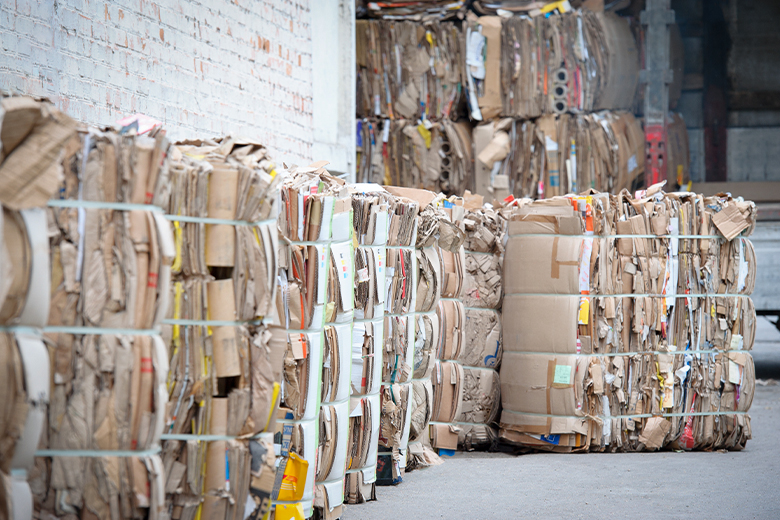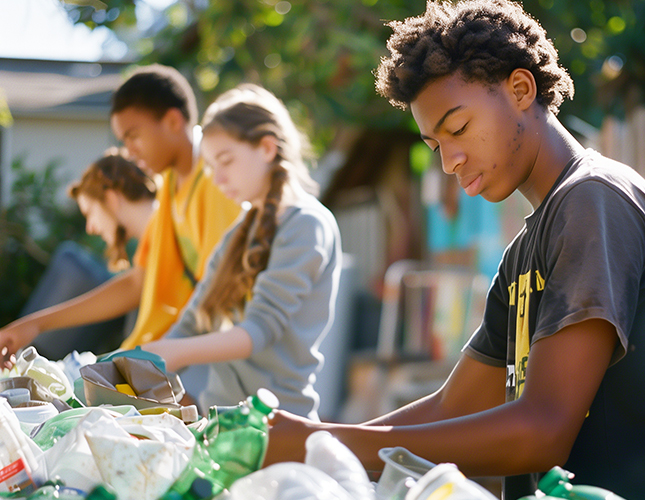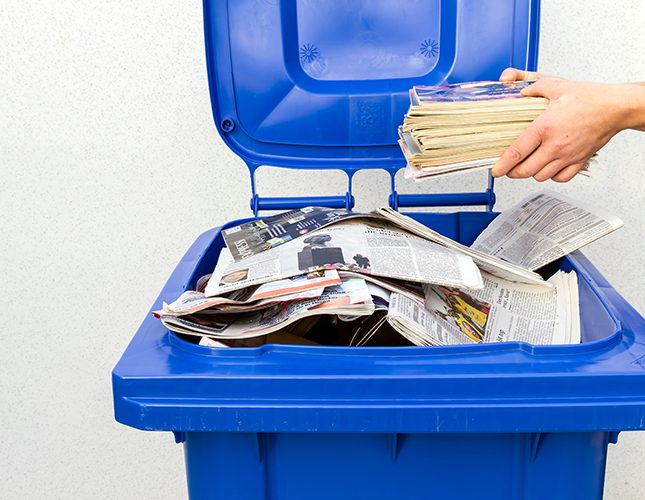You want to know more about recycling paper and cardboard in Quebec? From collection to reuse, sorting and processing, it all starts with what goes into the blue bin!
What goes in the bin:
Most of the paper and cardboard goes into the recycling bin. Here is a detailed list of what goes into the bin produced by Recyc-Québec. Feel free to download their mobile app Ça va où?
- Newspapers, flyers, catalogues, magazines
- Sheets of paper (including staples) and envelopes
- Boxes of cereals, frozen foods, laundry soap, shoes, tubes and rolls of cardboard, etc.
- Flat cardboard boxes
- Cardboard rolls
- File folders
- Paper bags
- Directories
- Multi-ply cartons of milk and juice (e.g., Tetra Pak type containers)
- Egg cartons
- Brown grocery paper bags
- Promotional inserts
- Invoices
- Lottery tickets
Separation of paper and cardboard in sorting centres
There are different steps to separate the materials according to their composition.
One step is to perform mechanical sorting using paper and cardboard separators to separate the fibers from the containers (glass, metal and plastic). The fibers, which are lighter, remain above the rolls while the containers, being heavier, fall into a pit.
A second screening of contaminants is done using infra-red optical sorters that can differentiate between fiber and plastic.

Once the materials are separated, they are stored and then sent to a press that will turn them into bales.
Bundles of mixed paper are an amalgam of several types of fibers of different qualities and varied composition. Quality will be determined by the accepted contamination rate for bales from paper and paperboard recycling in Quebec.
Quality and characterization of bales
The quality of the bales depends on the one hand, on what the sorting centre receives upstream and, on the other, on the performance of the equipment and the processes put in place.
It is the presence of a certain amount of contaminants, other materials such as glass or plastic that can be found in the paper and cardboard, that will determine the quality of the outgoing material.
The latest results of the characterization report of RECYC-QUÉBEC and Éco Entreprises Québec showed that bundles of mixed paper in the province were composed of an average of 75% generally accepted fibers, thus a 25% contamination level
Between the first phase of bale characterization in 2018-2019 and the second phase in 2019-2020, this provincial average rate has increased to nearly 80%.
For its part, as an example, since Ricova has resumed the Saint-Michel sorting centre operations, it has reduced the rate of contamination of outgoing materials from 35% to 15%. Ricova is continuing its investments and improvements to reduce the level of contamination below 10%.
The quality of the bales and the ability of the domestic market to absorb the materials leaving the sorting centres in Quebec will determine where this new raw material will be valued.
What markets for paper and paperboard recycling materials in Quebec?
Few paper mills currently accept bundles of mixed paper in Quebec.
Indeed, these paper mills use very little of this type of material made of different mixed papers.
If Quebec wants to develop these materials, it must diversify and develop new markets.
International buyers have different needs and standards than Quebec paper mills. This is particularly the case for Asian markets, and India in particular.
At the time of the recycling crisis in 2020, it was because it had been working for years to find new markets that Ricova was able to help all sorting centres in Quebec, and across Canada, to export to these international markets and thus find outlets for their materials.
What outlets for recycled paper and cardboard?
After removing the adhesives, inks, staples, etc., the paper will be turned into new pulp for use in new newsprint, egg boxes, envelopes, paper towels or tissue paper.
Cardboard can then be transformed into new cardboard products, such as corrugated cardboard boxes, kraft paper packaging or building materials.
In short, the recycling of paper and cardboard in Quebec is well established and efficient. A good reason to make a few small gestures that will promote the quality of bundles of mixed paper:
- Fold your cartons before putting them in the collection bin, to optimize the filling of the bins.
- Do not leave leftover food in packages.
- Avoid cutting paper into small pieces, as this reduces the length of cellulose fibers and makes recycling more difficult.








